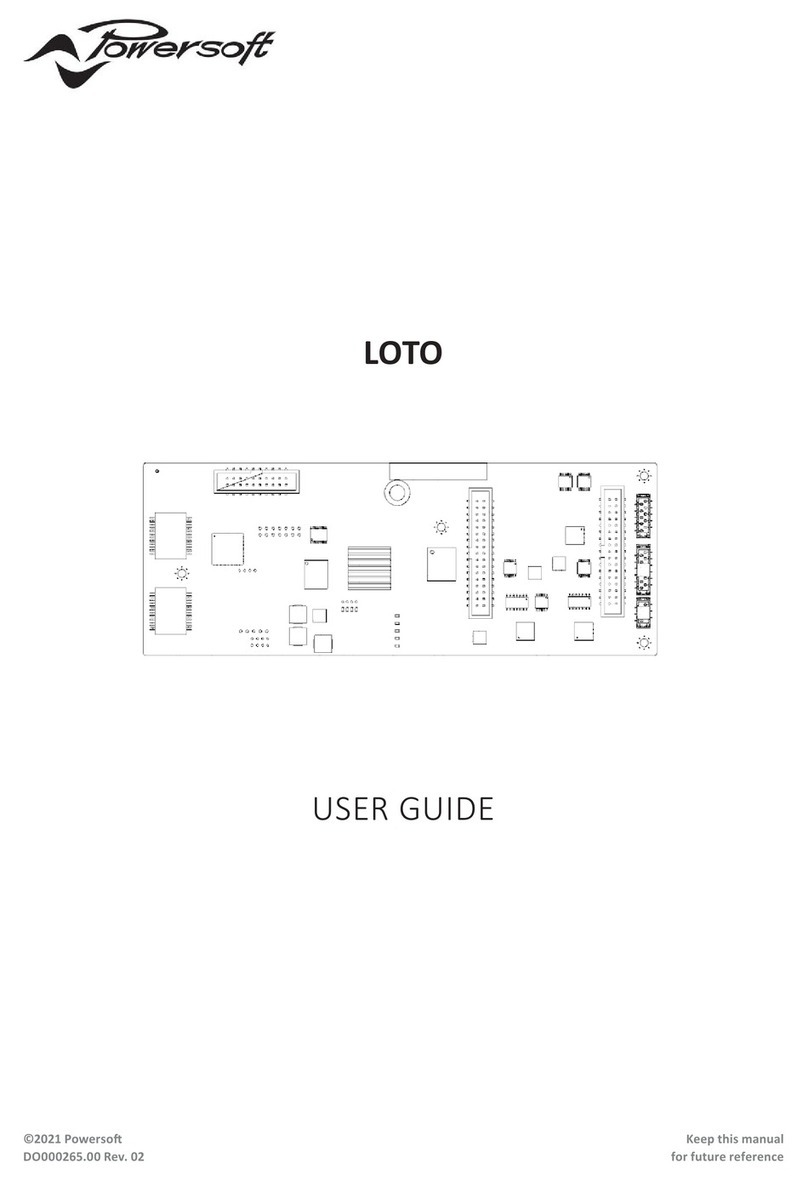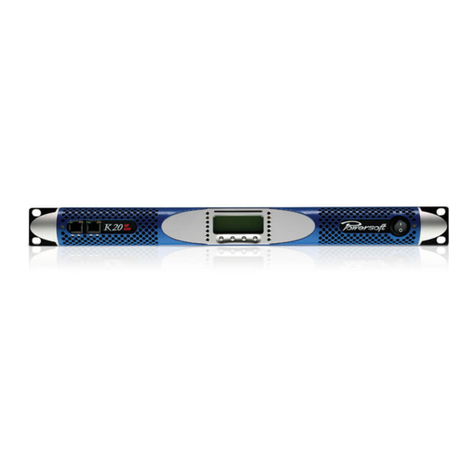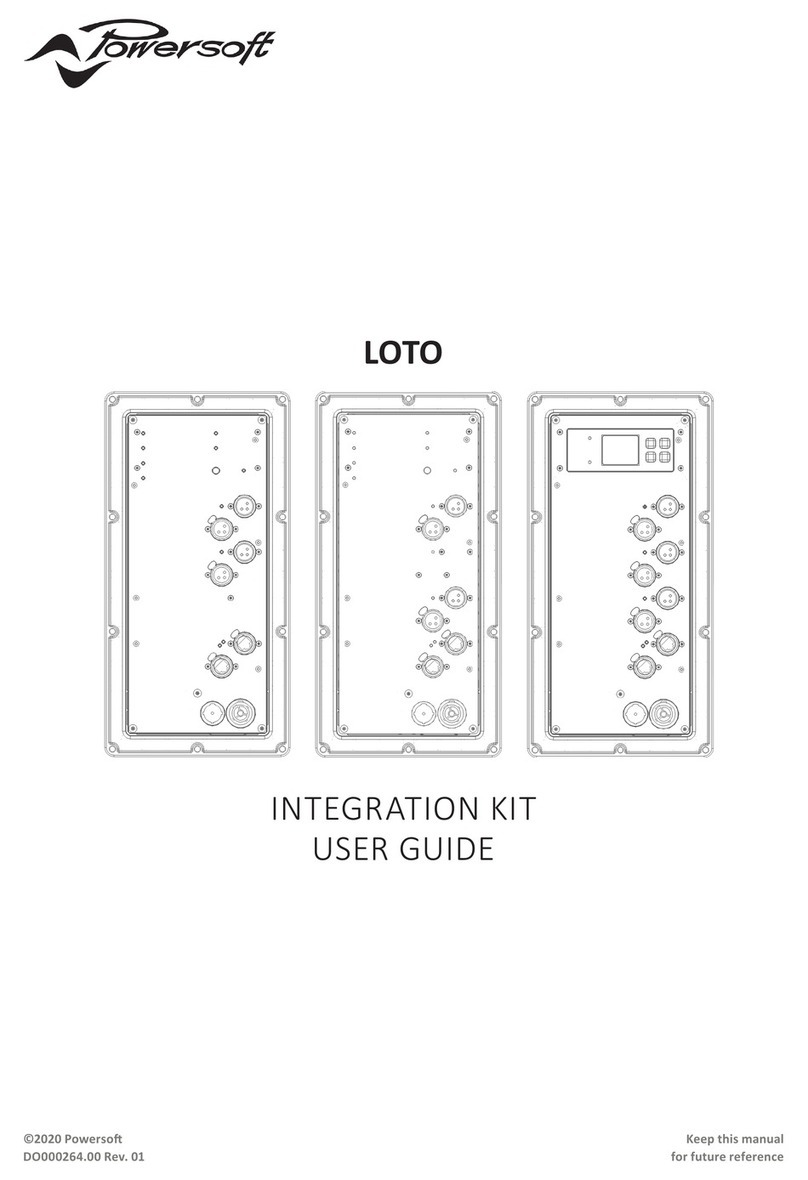
Instrucciones de seguridad importantes 3
Este módulo amplicador está diseñado para
ser instalado dentro de otros dispositivos y
debe vericarse en el producto nal. PRECAUCIÓN
RIESGO DE CHOQUE ELÉCTRICO
NO ABRA LA UNIDAD
Esta unidad ha sido diseñada y fabricada para garantizar su seguridad personal.
Pero SU USO INADECUADO PUEDE RESULTAR EN UNA POTENCIAL DESCARGA
ELÉCTRICA O RIESGO DE FUEGO.
Con el fin de no anular las garantías incorporadas en este producto, siga
las siguientes reglas básicas para su instalación, uso y servicio. Por favor lea
cuidadosamente estas “Garantías Importantes” antes de su uso.
1. Lea estas instrucciones.
2. Guarde estas instrucciones.
3. Preste atención a todas las advertencias.
4. Siga todas las instrucciones.
5. No use este aparato cerca del agua.
6. No bloquee las aberturas de ventilación. Realice la instalación de
acuerdo con las indicaciones de Powersoft.
7. No instale cerca ninguna fuente de calor como, por ejemplo,
radiadores, rejillas de calefacción, hornos u otros aparatos que
produzcan calor.
8. No elimine el diseño de seguridad del enchufe, ya sea del tipo po-
larizado o con conexión a tierra.
9. Use exclusivamente los dispositivos/accesorios indicados por
Powersoft.
10. El servicio técnico debe realizarlo siempre personal cualificado. Se
requerirá servicio de asistencia técnica cuando el aparato sufra
algún tipo de daño como, por ejemplo, que el cable de alimentación
o el enchufe estén dañados, que se haya derramado líquido o hayan
caído objetos dentro del aparato, que éste se haya expuesto a la llu-
via o humedad, que no funcione normalmente o que se haya caído.
11. Este aparato deberá ser conectado a un enchufe de salida de red
eléctrica con una protectora conexión a tierra.
NO EXPONGA ESTE UNITAD A LA LLUVIA O LA HUMEDAD,
GOTEO O SALPICADURAS. NO COLOQUE OBJETOS LLENOS DE
LÍQUIDOS, TALES COMO VASIJAS, SOBRE EL APARATO.
TERMINALES DE LOS ALTAVOCES PODRÍA SER PELIGROSO, SI
SU CONEXIÓN SE UTILIZA EL ALTAVOZ MODO PUENTE.
ADOPTAR TÉCNICAS CORRECTAS DE CONEXIÓN Y
AISLAMIENTO CUANDO SE USA CONEXIÓN DE ALTAVOZ MODO
PUENTE.
EL TRIÁNGULO CON EL RAYO ES USADO PARA ALERTAR AL
USUARIO DEL RIESGO DE DESCARGA ELÉCTRICA.
EL TRIÁNGULO CON EL SIGNO DE EXCLAMACIÓN ES USADO
PARA ALERTAR AL USUARIO DE INSTRUCCIONES DE OPERACIÓN
Y MANTENIMIENTO IMPORTANTES.
EL MARCADO CE INDICA QUE EL PRODUCTO CUMPLE TODAS
LAS DIRECTIVAS EUROPEAS VIGENTES
SÍMBOLO PARA TIERRA/CONEXIÓN A TIERRA.
SÍMBOLO INDICANDO QUE EL EQUIPO ES SOLO PARA USO
INTERIOR.
SÍMBOLO PARA LA CONFORMIDAD CON LA DIRECTIVA 2012/19/
EC DEL PARLAMENTO EUROPEO SOBRE EL DESECHO DE
EQUIPOS ELÉCTRICOS Y ELECTRÓNICOS (WEEE por sus siglas
en Inglés).
+35°C
0 °C
ENTRE 0°C Y +35°C
DEGRADACIÓN POR ENCIMA DE 35°C.
10%
90%
%ENTRE 10% Y 90% DE HUMEDAD (SIN CONDENSADO).
NO USE LA UNIDAD EN ALTITUDES SOBRE LOS 2000 METROS.
NO USE LA UNIDAD EN AMBIENTES TROPICALES.
ADVERTENCIA: PARA REDUCIR EL RIESGO DE DESCARGA
ELÉCTRICA, NO INTENTE ABRIR NINGUNA PARTE DE LA UNIDAD.
NO EXISTEN PARTES INTERNAS REPARABLES PARA EL USUARIO.
REFIERA LA REVISIÓN A PERSONAL DE MANTENIMIENTO
CALIFICADO.
LA CONEXIÓN A LA RED ELÉCTRICA DEBERÁ SER EFECTUADA
SOLAMENTE POR UNA PERSONA QUE ESTÉ CAPACITADA
EN EL ÁREA DE ELECTROTÉCNICA DE ACUERDO A LOS
REQUERIMIENTOS NACIONALES DE LOS PAÍSES DONDE LA
UNIDAD SEA VENDIDA.
VERIFIQUE QUE SU CONEXIÓN A LA RED ELÉCTRICA ES CAPAZ
DE SATISFACER LOS ÍNDICES DE ENERGÍA DE ESTE DISPOSITIVO.
EL FABRICANTE NO SE HACE RESPONSABLE POR DAÑOS CAUSADOS
A PERSONAS, OBJETOS O DATOS DEBIDO A UNA CONEXIÓN A TIERRA
INAPROPIADA O FALTANTE.
CONTACTE AL CENTRO DE SERVICIO AUTORIZADO PARA
MANTENIMIENTO DE RUTINA O EXTRAORDINARIO.
ES ABSOLUTAMENTE NECESARIO VERIFICAR ESTOS REQUERIMIENTOS
FUNDAMENTALES DE SEGURIDAD Y, EN CASO DE DUDA, EXIJA UN
CORRECTO CHEQUEO POR PARTE DE UN PERSONAL CALIFICADO.
Instrucciones de seguridad importantes | v































